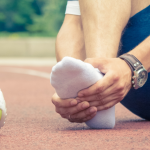Why does my shoulder hurt when I serve?
Tennis is a dynamic sport involving a large amount of repetitive shoulder actions occurring at high velocity. The combination of this velocity and repetitiveness can contribute to pain and dysfunction in the shoulder joint as well as the muscles and tendons surrounding it.
How do injuries happen?
The tennis serve tends to be the action that causes the most problems in the shoulder. This can be due to the overhead arm position being functionally unstable. This overhead position requires both stabilisation from the rotator cuff muscles, and strength and endurance through the muscles of the shoulder girdle to produce the power required for an effective serve. Fatigue of these muscles can result in poor mechanics through the serve, causing overload and irritation to the tendons and soft tissue structures of the shoulder joint. This can lead to common causes of shoulder pain in tennis players, rotator cuff tendinopathy and subacromial bursitis. These injuries are generally captured under the term of subacromial impingement, referencing the spot under the bony tip of the shoulder at which irritation often occurs.
These injuries present as pain around the shoulder that can radiate down the arm. You might find that your regular range of motion is limited and that there is weakness in the shoulder with certain movements or positions such as reaching overhead or out to the side.
As pain persists, adaptive tightness and weakness can present through the muscles around the shoulder blade as well, often perpetuating the injury and resulting in a shoulder girdle that sits in a suboptimal position for the activities it is trying to perform.
What can I do about it?
After a thorough assessment of the shoulder’s range of motion, movement patterns and strength, your Physiotherapist will work with you to develop a treatment plan. This may include short-term rest, icing or using anti-inflammatories to settle acute symptoms, soft tissue therapy and supportive taping. What your treatment plan will always involve is specific strengthening exercises for muscles of the shoulder girdle and rotator cuff. These exercises are the key to a safe and effective return to tennis.
Strengthening the muscles associated with the shoulder blade creates a stable base for the shoulder to rotate on, and allows the rotator cuff muscles to function in an optimal environment. Strengthening the rotator cuff increases its capacity to handle the repetitive actions and stresses that are involved in a tennis match.
Consideration will also be given to your overall biomechanics to ensure optimal efficiency in your technique, especially through your serve.
If you have a niggle or are experiencing new pain, don’t hesitate to book in with one of our wonderful Physiotherapists here.






